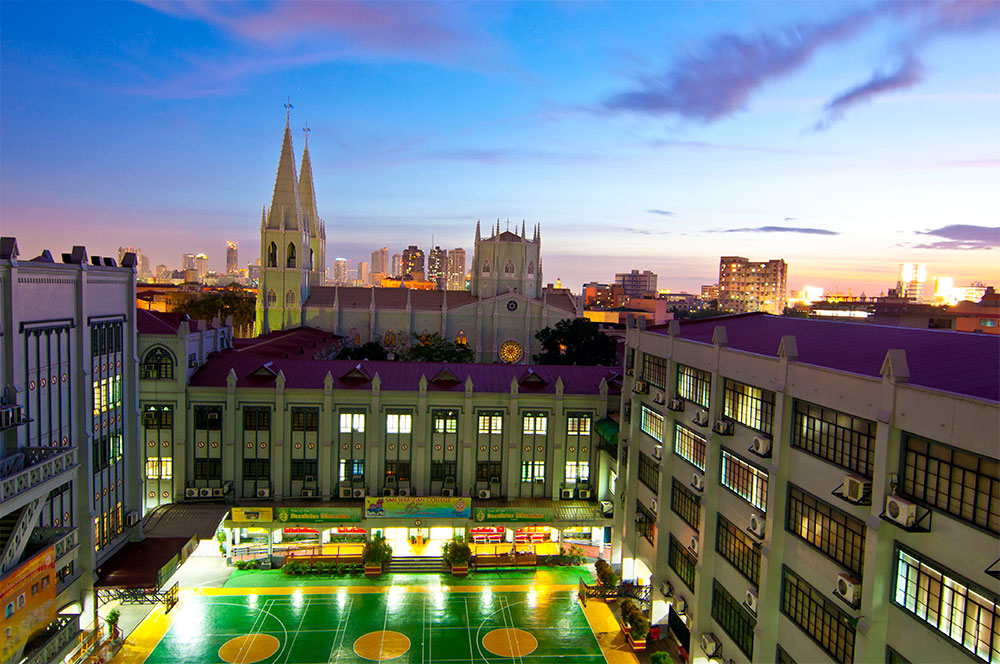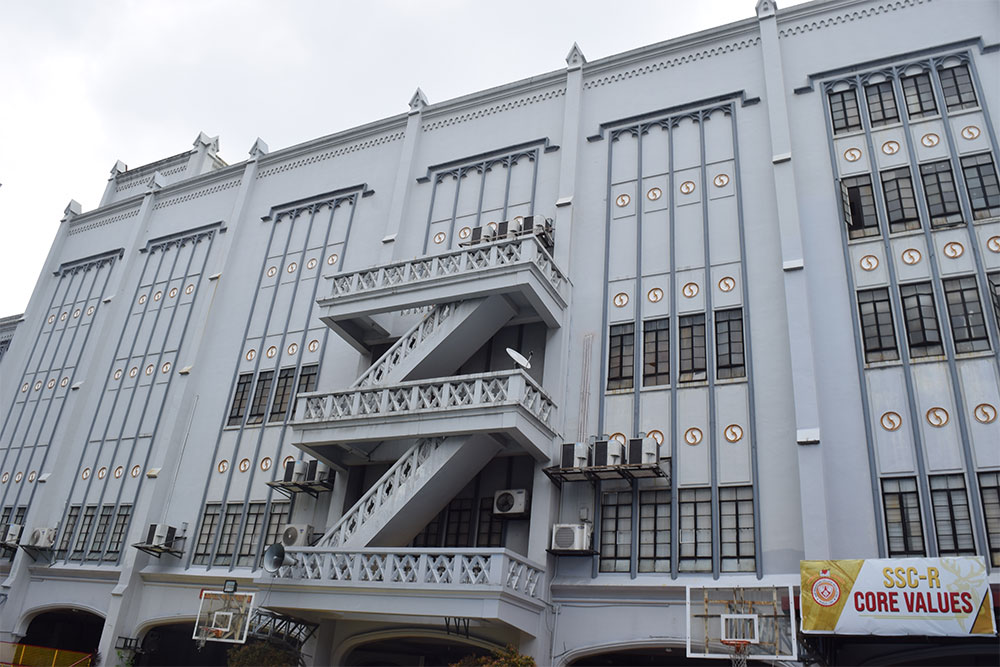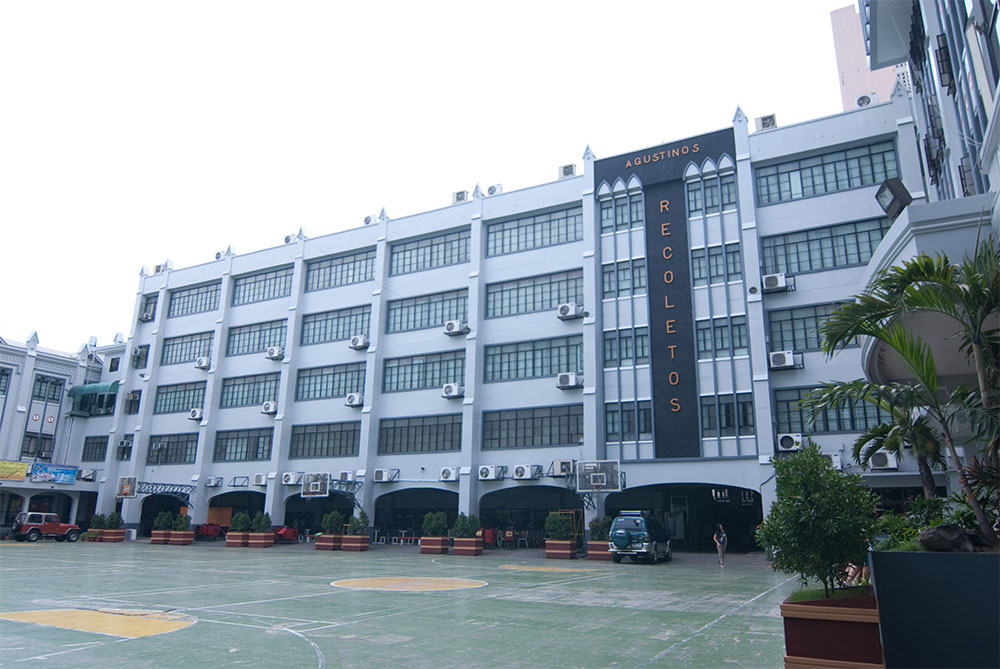The College, situated in the heart of Manila and named after a Roman centurion turned martyr–St. Sebastian, had a relatively humble beginning. Its first functional lone building was an old convent: a two-storey Hispanic edifice made of stone and wood with capiz shell windows. The building served as classrooms of the first batch of both the first and second year high school students. It was then an exclusive school for boys.
The Recollects’ desire to respond to the needs of the times triggered a string of physical metamorphoses that now characterize the spirit, the architecture and the educational ambiance of the College.
The first two-storey neo-gothic edifice modeled after the famous all-steel San Sebastian Church was inaugurated in 1947, replacing the first old stone and wood building.
In 1951, the old convent was demolished. In its place, was erected along gothic patterns a third building with a tower, known as the Administration building. At present the edifice houses the Offices of the President, VP for Academic Affairs, External Affairs Office, Information and Communications Technology Department, and the College Library. The convent for the religious occupies the whole second floor.
Three years after, a three-storey extension with a Gothic tower mirroring the tower of the Administration building was built. It was then called the Annex building. The Annex is home to the Hospitality Management laboratories and fully furnished mini-hotel, the Office of the Vice President for Religious Affairs, the Office of the Student Publication, The Sebastinian, the Property Administrator’s Office, the Sebastinian Community Development and Extension Office, the Psychology Laboratory, the Human Resource Development Center, the Student Development and Placement Center, and the Health Services Department..
At present, the two-construction forming a continuous u-shaped building is dedicated to the patron saint of the College – St. Sebastian.
Another neo-gothic edifice was built in 1958, previously known as the High School Building. It featured the era’s finest Auditorium–one of the city’s best with projectors, revolving stage and state-of-the-art facilities. The Auditorium with a seating capacity of 1,200 serves as venue for college activities. It is available to the public for various affairs. The St. Ezekiel Moreno Chapel is conveniently located at the ground floor of the building.
The building is now named after St. Ezekiel, patron for cancer patients and the patron saint of the Augustinian Recollects of the Philippine Province, while the Auditorium is offered to Fr. Diego Cera, OAR, the ingenious mind behind the famous bamboo organ of the Las Piñas Parish Church.
Another building constructed in 1966 is situated at the western end of the campus. The building houses the Elementary Department, College of Accountancy, Business Administration and Computer Studies (CABACS), College of Arts and Sciences (CAS), College of International Hospitality Management (CIHM), Research Center, Quality Assurance Office, ETEEAP Center, Vice President for Finance and Accounting Office, Vice President for Student Welfare, Electronic Data Processing Department, and Registrar. This building also houses the Student Affairs Office, the Seminar Room, the Little Theater (now dedicated to Fr. Domingo Carceller, OAR), Speech Laboratory, Communication Laboratories and Broadcast Studio, Computer ND Technology Laboratories, Natural Science Laboratories, Canteen, and other function rooms. The Elementary Department Library is found in the fourth floor of the building.
The Captain’s Galley and the Travel Laboratory of the CIHM department are the new features to the building dedicated to St. Monica – the mother of St. Augustine.
The newest addition to the SSC-R, Manila campus, is the St. Augustine building. This houses the College of Law and the Recoletos Law Center. It is a fully air-conditioned state-of-the-art multi-purpose building inaugurated on September 10, 1998, the Feast Day of St. Nicholas of Tolentine. The modern gymnasium with workout facilities located at the sixth floor is home to the Stags’ basketball team. The building has an expansive library facility, air-conditioned classrooms, first class facilities and multi-purpose halls.
The College of Law and its paralegal aid office for the poor, Sebastinian Office of Legal Aid (SOLA) call St. Augustine building its home.
SSC-R, Manila, cognizant of the need of the counter urban blight along C. M. Recto Avenue, decided to reserve three-store front offices to be leased to service companies needing presence in the University Belt Area.
This physical transformation of the SSC-R, Manila campus was equally substantiated by changes in the academic blueprint. To achieve the School Chapter’s noble purpose of meeting the pressing educational need of the war-ravaged nation, SSC-R, Manila, aside from focusing on primary and secondary education, widened its visionary zeal to include tertiary education in its program of education for the Filipino people.
An Institute of Liberal Arts was established with a two-year course leading to an Associate of Arts and Sciences degree in 1948. The Institute of Commerce was inaugurated in 1953. The Lacson Law College was absorbed by the College and became the Institute of Law on June 15, 1953. A co-educational two-year Secretarial Course was offered in 1972 to meet the demands of Philippine business and industry for trained office administrators and secretaries (the course was expanded and incorporated in the major field of computer science under the Institute of Commerce in 1994).
Aligning itself with the needs of the people, the whole collegiate level was made co-educational in 1973. The elementary department followed suit and accepted its first batch of female pupils in 1974. The first collegiate summer classes were offered the same year.
In the spirit of pioneering, SSC-R, Manila founded the Institute of Banking and Finance in 1974 (the Institute of Commerce absorbed the IBF in 1994). The Institute of Graduate Studies in response to the needs of business and industry for professional managers, academicians, entrepreneurs and managers offered the MBA program in 1976.
The decision of the High School Department to admit its first female students in 1986 made SSC-R, Manila completely co-educational in all departments.
The College’s advocacy of the Catholic faith prompted the opening of Master’s Program in Theology (MAT) with OAR theologians as its first students in 1987. The program accepted lay people the following year. The College of Accountancy, Business Administration and Computer Studies (CABACS) offers major fields of studies in accountancy, business management, computer science, information technology, financial management, legal management and marketing, while the College of Arts and Sciences gears its students in the fields of mass communications, political science and psychology. The College of International Hospitality and Management offers Tourism and Hotel and Restaurant Management courses.
In 1997, the SSC-R, Manila College of Law signed a Memorandum of Agreement (MOA) with the Integrated Bar of the Philippines (IBP), Surigao City Chapter, creating an extension law program in Surigao City. The program offered law enthusiasts of the CARAGA region to earn the Bachelor of Laws degree without leaving their work and residence. Although the program was put on hold by the year 2006, the law school resumed operations in year 2009-2010.
Consistent with the missionary spirit to go where God leads, the Board of Trustees of SSC-R extended its academic programs to the residents of Canlubang in the City of Calamba.
The formal ground breaking was held on May 2005 and in the following year June 2006 was the opening of San Sebastian College Canlubang Campus for first year students to the programs of Bachelor of Science with the following majors–Computer Science (BSCS), Tourism, Hospitality Management and Culinary Arts and Business Administration and the Bachelor of Arts in Communication.
Today, SSC-R, Manila boasts of and exhibits spacious and fully air-conditioned classrooms. Four well-equipped libraries–one for each department, five computer laboratories in the college department, one in the elementary department, and three in the high school department. Instructional Media Centers can be found in the tertiary, high school and elementary department libraries.
The College has a communication laboratories and broadcast studio, mini-hotel rooms and function laboratories, Hot and Cold Kitchen, Housekeeping Room and a GSM Bar. The CABACS has a special business laboratory used by practicum students and interested students. The Political Science and Legal Management Students have a Moot Curt to practice their legal and political prowess. Several concessionaires in the cafeteria area offer food, snacks and beverages. A group of dedicated licensed physicians, dentists and nurses trained in school emergencies and procedures man a fully equipped medical and dental clinic.
In the macroscopic Philippine educational setting, SSC-R, Manila has entrenched itself through its multi-faceted achievements that mirror the brand and quality education it furnishes the Filipinos. The Elementary and High School Departments enjoy the Level III Accredited status granted by the Federation of Accrediting Agencies of the Philippines through the Philippine Accrediting Association of Schools, Colleges and Universities (PAASCU) since 2010. The Business Administration, Arts and Sciences, Hospitality Management, Tourism Management, Computer Science, and Informational Technology programs are Level III Accredited status. The Accountancy program has a Candidate status for Formal Survey by PAASCU.
The Institute of Law gained approval from the Commission on Higher Education (CHED) to revise its curriculum designed to produce business and economic lawyers for the future. The Institute of Law is the first and only Asian Law School to become an associate member of the Southwestern Legal Foundation based in Dallas, Texas, which sponsors the Annual Dallas Academy of American and International Law. Beginning the school year 2010-2011, SSC-R College of Law was the fourth to be granted by the Supreme Court to offer the degree Juris Doctor (JD) in lieu of Bachelor of Laws (LLB) program. The legal aid to the poor and marginal members of society through SOLA is the College’s legacy to the poor of Manila.
The College has a long history of social involvement. The Recoletos Educational Assistance for Deserving Students (READS) is a program allowing students who are financially challenged but academically competent to earn a college degree. They are by the hundreds who are likewise trained the value of hard work and taught the sense of responsibility. Incorporating the Social Outreach Program of SSC-R, Sebastinian Outreach Foundation, Inc. (SOFI) now the Sebastinian Community Development and Extension Office (SCDEO), in May 13, 2004, has allowed the College to involve all employees from the administration to the student body to involve themselves in community-building activities. Seminars, distribution of goods, financial support and spiritual programs are extended to orphanages, charitable institutions, local government units and other parishes.
SSC-R has adopted in 2004 Brgy. Nepomuceno and, in 2009, Brgy.393, both depressed areas in Quiapo, Manila. SSC-R has introduced sustainable and long term community based programs to help residents become self-reliant and the community self-sufficient. In 1992, the Sebastinian Office of Legal Aid (SOLA) was established to extend legal assistance to the indigent and the poor who are victims of societal injustices. Volunteer faculty members from SSC-R College of Law are their supervising lawyers’ gratis et amore.
The Campus Ministry Office has continuously served the whole community through formative, pastoral, liturgical, pedagogical and sacramental programs. Twice, the Eucharist is celebrated each day for the community. Retreats and recollections are scheduled for all members of the community within each academic year. Spiritual direction and counseling are given as services to those most in need.
The students on their part have reaped glory, prestige and honor for the School through their remarkable success in off-campus competitions in various fields of endeavors. The students have excelled in inter-collegiate competitions in drama, literary musicals, and sports,
skill demonstrations in co-curricular and extra-curricular activities. SSC-R, Manila has established commendable National Collegiate Athletic Association (NCAA) records and became undisputed champions for years in the fields of basketball, volleyball, chess and track and field in the junior and senior divisions. The DMST/ROTC cadets have annually garnered awards in drill competitions. Many Sebastinians have won major inter-collegiate awards in the fields of oratory, song, declamation, debate and science exhibits. Numerous plays and musicals have been produced in campus and off-campus by the Student Theater and singing groups.
The Recoletos Law Center has become a melting pot of BAR reviewees who graduated from the best Law schools of the land. It has consistently produced BAR topnotchers.
The SSC-R, Manila envisions a continuance of its mission, vision and objectives for the greater glory and honor of God. The College also vows to continue fulfilling the three-fold mission—the development of person, the promotion of local culture and the welfare of society–in providing quality, Catholic and community oriented education for the Filipinos beyond the 21st Century.













